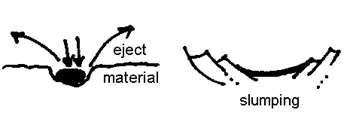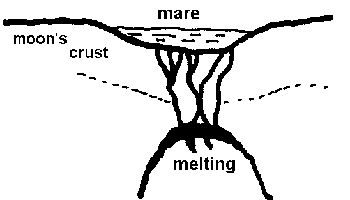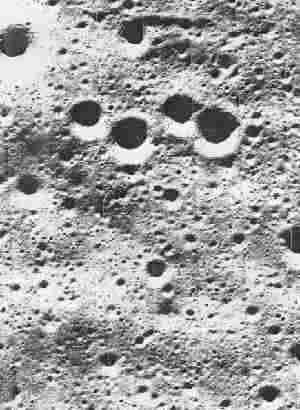BACKGROUND:
The surfaces of the terrestrial
planets are covered with impact craters, except for the Earth. Many of the
Solar System’s moons also have many craters. Impact craters form when a
meteroite strikes the surface. The impact hits with so much force that it  compresses
the rock it strikes, forming the crater. The impact also vaporizes the
impacting object. This impact plus the rebound of the compressed rock ejects
material out of the crater. This material may spread up to thousands of
kilometers away, depending on how much energy is released. The shape of the
crater may change if its walls begin to slump inward, partially filling it
up as shown in the figure to the left.
compresses
the rock it strikes, forming the crater. The impact also vaporizes the
impacting object. This impact plus the rebound of the compressed rock ejects
material out of the crater. This material may spread up to thousands of
kilometers away, depending on how much energy is released. The shape of the
crater may change if its walls begin to slump inward, partially filling it
up as shown in the figure to the left.
Craters may also be destroyed by
surface processes, such as weathering, and flows of water, wind, and ice.
This is why craters are rare on Earth. Old craters have been destroyed.
Our understanding of the origin of
craters was limited until pictures and samples were returned from our own
Moon's surface. We now have good photographic evidence for craters from the
other terrestrial planets, especially Mars and Venus. Craters on these
planets are difficult to interpret; some scientists think that some of them
may be volcanic in origin.
 On
the Moon, the floor of a typical crater is below the average level of the
surface. The crater is surrounded by a raised rim. Ejected material appears
as piles of rubble or loose rock in a zone around the crater, or from larger
craters, as a system of rays. Some craters are cut by rills, which are
cracks in the surface. Rills may be faults, possibly caused by ancient
tectonic activity or cooling processes.
On
the Moon, the floor of a typical crater is below the average level of the
surface. The crater is surrounded by a raised rim. Ejected material appears
as piles of rubble or loose rock in a zone around the crater, or from larger
craters, as a system of rays. Some craters are cut by rills, which are
cracks in the surface. Rills may be faults, possibly caused by ancient
tectonic activity or cooling processes.
Some very large lunar impact craters
are filled by volcanic rock very similar to the terrestrial igneous rock
basalt. These filled craters are usually called mare, from the Latin
word for ocean. Scientists suggest that after a large impact, molten rock
leaked up from the interior of the Moon along cracks, partially filling the
crater.
In this activity the students first
make their own craters, and then observe real craters using pictures from
the lunar surface.
PROCEDURE:
- Explain how craters form to the students. You may wish to draw the
diagrams shown in the background information to help. Explain the
probable origin of lunar mare to the class. Again, you may wish to draw
the diagram above on the board. Tell the student that they are going to
make craters, and then look for real craters on the Moon.
- Have the students work in groups. Have the students follow the
directions on the lab sheet, or if you prefer, assemble the cratering
materials in advance. Pour flour into each pan and level it into a layer
at least 4-5 cm thick. Have the students work outside or spread
newspapers on the classroom floor. Have each student stand on a chair
and drop a spoonful of flour into the pan from a height of about a
meter. This will form mini-craters in the flour that have the same
raised rims and sloping sides as real craters.
If you have corn meal, you may want to mix that in with the flour. It
gives the crater a more defined rim.
- Alternatively, you may want to make several craters with a few
students, and have the rest of the class observe and record the craters
on their lab sheets.
 You can also experiment by changing the angle of impact, by throwing
the flour into the pan at an angle. This is how most "real"
craters form; rarely if ever does an object strike exactly perpendicular
to the Earth’s surface. Be careful, angled impacts can be messy! You
should see, that unless the impact angle is very shallow, a circular
crater is created. You may want to discuss with students that impacting
objects do not hit the Earth straight on.
You can also experiment by changing the angle of impact, by throwing
the flour into the pan at an angle. This is how most "real"
craters form; rarely if ever does an object strike exactly perpendicular
to the Earth’s surface. Be careful, angled impacts can be messy! You
should see, that unless the impact angle is very shallow, a circular
crater is created. You may want to discuss with students that impacting
objects do not hit the Earth straight on.
- Divide the students into groups of four. Give each group a packet of
Moon photographs. Make sure that they return the material to the same
packet. Give each student a magnifier. Have them look at each of the
four pictures to try and determine which ones show craters and which
ones do not. Have them count the number of craters on each photo, and
record the information on their lab sheets.
Have the students try to detect the difference between a mare and an
impact crater. This is actually hard to see. You may wish to hint that
the very large craters are usually mare. Instruct the students to look
at the shadow. They may be able to tell the difference between a hill
and a depression. But this is difficult also. It is good for the
students to see the difficulty in this interpretation. Facing ambiguity
is an important part of doing science.